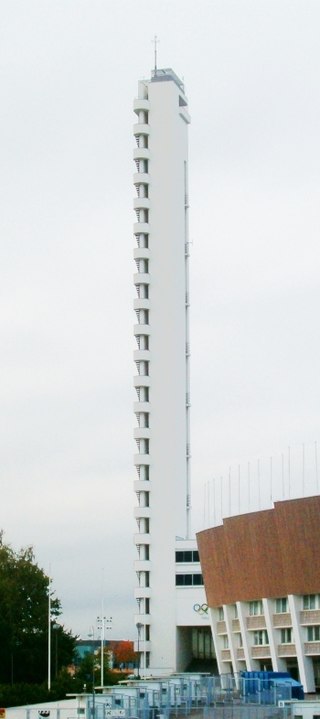This article needs additional citations for verification .(January 2021) |


Uno Åhrén (6 August 1897 – 8 October 1977) was a Swedish architect and city planner, and a leading proponent of functionalism in Sweden. [1]
This article needs additional citations for verification .(January 2021) |


Uno Åhrén (6 August 1897 – 8 October 1977) was a Swedish architect and city planner, and a leading proponent of functionalism in Sweden. [1]
Uno Emrik Åhrén was born in Stockholm, Sweden. He graduated as an architect at the KTH Royal Institute of Technology in Stockholm in 1918. He was City Planning Manager in Gothenburg 1932-1943 and head of the Riksbyggen 1943-1945. He was appointed professor of urban construction at the Royal Institute of Technology from 1947 through 1963. [2]
In 1930 Åhrén was one of the designers for the Housing Exhibition of the Stockholm International Exhibition, and in 1931 he was one of the six co-authors of the 1931 manifesto, Acceptera , a plea for acceptance of functionalism, standardization, and mass production as a cultural change in Sweden. [3]
Åhrén collaborated with the sociologist, reformer and Nobel Memorial Prize in Economic Sciences winner Gunnar Myrdal from 1932 though 1935 on a social housing commission, and in 1934 they co-authored The Housing Question as a Social Planning Problem, a work that would prove influential in the structuring of the Swedish Social Democratic Party, the Folkhemmet. In fact Prime Minister Per Albin Hansson, who coined the word Folkhemmet, himself moved into an Åhrén-designed functionalist house in 1936. [4]
Åhrén died at Arvika during 1977.

Alva Myrdal was a Swedish sociologist, diplomat and politician. She was a prominent leader of the disarmament movement. She, along with Alfonso García Robles, received the Nobel Peace Prize in 1982. She married Gunnar Myrdal in 1924; he received the Nobel Memorial Prize in Economic Sciences in 1974, making them the sixth ever married couple to have won Nobel Prizes, and the first to win independent of each other.

In architecture, functionalism is the principle that buildings should be designed based solely on their purpose and function. An international functionalist architecture movement emerged in the wake of World War I, as part of the wave of Modernism. Its ideas were largely inspired by a desire to build a new and better world for the people, as broadly and strongly expressed by the social and political movements of Europe after the extremely devastating world war. In this respect, functionalist architecture is often linked with the ideas of socialism and modern humanism.
The year 1930 in architecture involved some significant events.

The Student Union at the Royal Institute of Technology is the students' union at the Royal Institute of Technology in Stockholm, Sweden. It is affiliated with the Stockholm Federation of Student Unions.

Vällingby is a suburban district in Västerort in the western part of Stockholm Municipality, Sweden.

Erik Gunnar Asplund was a Swedish architect, mostly known as a key representative of Nordic Classicism of the 1920s, and during the last decade of his life as a major proponent of the modernist style which made its breakthrough in Sweden at the Stockholm International Exhibition (1930). Asplund was professor of architecture at the Royal Institute of Technology from 1931. His appointment was marked by a lecture, later published under the title "Our architectonic concept of space." The Woodland Crematorium at Stockholm South Cemetery (1935-1940) is considered his finest work and one of the masterpieces of modern architecture.

Ralph Erskine ARIBA was a British architect and planner who lived and worked in Sweden for most of his life.

Sven Gottfrid Markelius was a Swedish modernist architect. Markelius played an important role in the post-war urban planning of Stockholm, for example in the creation of the model suburbs of Vällingby (1950s) and Farsta (1960s).
Folkhemmet is a political concept that played an important role in the history of the Swedish Social Democratic Party and the Swedish welfare state. It is also sometimes used to refer to the long period between 1932 and 1976 when the Social Democrats were in power and the concept was put into practice, but also works as a poetic name for the Swedish welfare state. Sometimes referred to as "the Swedish Middle Way", folkhemmet was viewed as midway between capitalism and socialism. The base of the folkhem vision is that the entire society ought to be like a family, where everybody contributes, but also where everybody looks after one another. The Swedish Social Democrats' successes in the postwar period is often explained by the fact that the party managed to motivate major social reforms with the idea of the folkhem and the national family's joint endeavor.
This article covers the architecture of Sweden from a historical perspective.

Nordic Classicism was a style of architecture that briefly blossomed in the Nordic countries between 1910 and 1930.

The Stockholm Exhibition was an exhibition held in 1930 in Stockholm, Sweden, that had a great impact on the architectural styles known as Functionalism and International Style.
Colonel Bengt Folke Bengtsson was a Swedish Army officer. He served in the Air Defense Artillery Branch and finished his military career as Inspector of the Air Defence from 1953 to 1957.

Södra Ängby is a residential area blending functionalism with garden city ideals, located in western Stockholm, Sweden, forming part of the Bromma borough.

Carl Malmsten was a Swedish furniture designer, architect, and educator who was known for his devotion to traditional Swedish craftmanship (slöjd) and his opposition to functionalism. He "considered the rationalization of the home according to functionalist principles a debasement of its traditional role as an intimate place for gathering and repose".

acceptera (1931) is a Swedish modern architecture manifesto written by architects Gunnar Asplund, Wolter Gahn, Sven Markelius, Eskil Sundahl, Uno Åhrén, and art historian Gregor Paulsson. Claiming that Swedish “building-art” (byggnadskonst) has failed to keep pace with the revolutionary social and technological change sweeping Europe in the early 20th century, the authors argue that the production of housing and consumer goods must embrace a functionalist orientation in order to meet the particular cultural and material needs of both modern society and the modern individual. Combining social analysis with an iconoclastic critique of contemporary architecture and handicraft, acceptera ardently calls upon its readers not to shrink back from modernity, but rather to “accept the reality that exists—only in that way have we any prospect of mastering it, taking it in hand, and altering it to create a culture that offers an adaptable tool for life.”

Helena Hernmarck is a Swedish tapestry artist who lives and works in the United States. She is best known for her monumental tapestries designed for architectural settings.

Hillevi Svedberg (1910–1990) was an early Swedish female architect whose work was inspired by Functionalism. She is remembered for introducing showers and bathrooms in working-class housing and for her low-cost collective housing developments with children's care centres. One of her most successful buildings was the Yrkeskvinnornas Kollektivhus or YK-House (1939) in Stockholm's Gärdet district which she designed in collaboration with Albin Stark (1885–1960).
Werner Taesler was a German architect active in the Soviet Union and in Sweden.